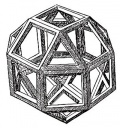Haptic perception
From The Art and Popular Culture Encyclopedia
|
Related e |
|
Featured: |
Haptic perception (Template:Lang-gr "palpable", haptikόs "suitable for touch") means literally the ability "to grasp something". Perception in this case is achieved through the active exploration of surfaces and objects by a moving subject, as opposed to passive contact by a static subject during tactile perception. The term Haptik was coined by the German Psychologist Max Dessoir in 1892, when suggesting a name for academic research into the sense of touch in the style of that in "acoustics" and "optics".
Gibson (1966) defined the haptic system as "[t]he sensibility of the individual to the world adjacent to his body by use of his body". Gibson and others further emphasized what Weber had realized in 1851: the close link between haptic perception and body movement, and that haptic perception is active exploration.
The concept of haptic perception is related to the concept of extended physiological proprioception, according to which when a tool such as a stick is used, perceptual experience is transparently transferred to the end of the tool.
Haptic perception relies on the forces experienced during touch. This research allows the creation of "virtual", illusory haptic shapes with different perceived qualities, which has clear application in haptic technology.
Exploratory procedures
People can rapidly and accurately identify three-dimensional objects by touch. They do so through the use of exploratory procedures, such as moving the fingers over the outer surface of the object or holding the entire object in the hand.
The following exploratory procedures have been identified so far:
- Lateral motion
- Pressure
- Enclosure
- Contour following
Thus gathered object or subject properties are size, weight, contour, surface and material characteristics, consistency and temperature.
Impairments of haptic sensitivity
Haptic sensitivity can be impaired by a multitude of diseases and disorders, predominantly relating to skin injuries (incisions, burns, etc) and nerve lesions (through injury or impaired circulation). Additionally, loss of sensitivity (neuropathy) may be caused by metabolic, toxic and/or immunologic factors. Examples of medical conditions that can cause neuropathies are diabetes mellitus, chronic kidney disease, thyroid dysfunction (hyper- and hypothyroidism) as well as hepatitis, liver cirrhosis and alcohol dependency.
Loss of the sense of touch is a catastrophic deficit that can impair walking and other skilled actions such as holding objects or using tools.
See also

